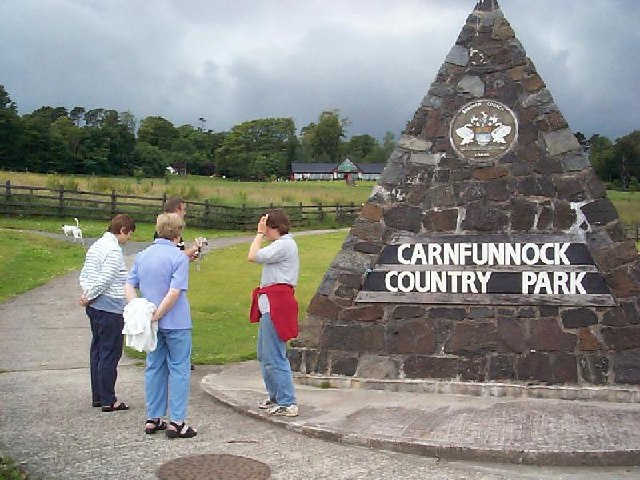|
Carnfunnock Country Park
Carnfunnock Country Park is a 191-hectare park located between Drains Bay and Ballygally, near Larne, County Antrim, Northern Ireland. It is situated on the A2 Antrim Coast Road, 3.5 miles north of Larne. The park consists of mixed woodland, gardens, walking trails and coastline with views of the Antrim Coast and North Channel. and is owned and run by Mid and East Antrim Borough Council. Features The walled garden with its sundials and wooden sculptures is open all year round along with a maritime themed outdoor adventure playground, golf driving range and academy, way-marked walks, orienteering course, geocaching, wildlife garden, public toilets and picnic sites. The Cafe also operates at weekends throughout the year and there is a Parkrun every Saturday morning (subject to ground conditions). 1st Carnfunnock Scouts, which belongs to The Scout Association, was formed in October 2015 and meets regularly throughout the year. In 2010 the park was approved as a venue for civil ... [...More Info...] [...Related Items...] OR: [Wikipedia] [Google] [Baidu] |
Marquess Of Donegall
Marquess of Donegall is a title in the Peerage of Ireland held by the head of the Chichester family, originally from Devon, England. Sir John Chichester sat as a Member of Parliament and was High Sheriff of Devon in 1557. One of his sons, Sir Arthur Chichester, was Lord Deputy of Ireland from 1605 to 1616. In 1613, he was raised to the Peerage of Ireland as Baron Chichester, of Belfast in County Antrim. When he died childless in 1625 the barony became extinct. However, in the same year the Chichester title was revived in favour of his younger brother, Edward Chichester, who was made Baron Chichester, of Belfast in the County of Antrim, and Viscount Chichester, of Carrickfergus in County Antrim. Both titles are in the Peerage of Ireland. He was succeeded by his eldest son, Arthur Chichester. A distinguished soldier, he was created Earl of Donegall in the Peerage of Ireland in 1647 (one year before he succeeded his father), with remainder to the heirs male of his father. He ... [...More Info...] [...Related Items...] OR: [Wikipedia] [Google] [Baidu] |
Forests And Woodlands Of Northern Ireland
A forest is an ecosystem characterized by a dense community of trees. Hundreds of definitions of forest are used throughout the world, incorporating factors such as tree density, tree height, land use, legal standing, and ecological function. The United Nations' Food and Agriculture Organization (FAO) defines a forest as, "Land spanning more than 0.5 hectares with trees higher than 5 meters and a canopy cover of more than 10 percent, or trees able to reach these thresholds ''in situ''. It does not include land that is predominantly under agricultural or urban use." Using this definition, '' Global Forest Resources Assessment 2020'' found that forests covered , or approximately 31 percent of the world's land area in 2020. Forests are the largest terrestrial ecosystems of Earth by area, and are found around the globe. 45 percent of forest land is in the tropical latitudes. The next largest share of forests are found in subarctic climates, followed by temperate, and subtropic ... [...More Info...] [...Related Items...] OR: [Wikipedia] [Google] [Baidu] |
Parks In County Antrim
A park is an area of natural, semi-natural or planted space set aside for human enjoyment and recreation or for the protection of wildlife or natural habitats. Urban parks are green spaces set aside for recreation inside towns and cities. National parks and country parks are green spaces used for recreation in the countryside. State parks and provincial parks are administered by sub-national government states and agencies. Parks may consist of grassy areas, rocks, soil and trees, but may also contain buildings and other artifacts such as monuments, fountains or playground structures. Many parks have fields for playing sports such as baseball and football, and paved areas for games such as basketball. Many parks have trails for walking, biking and other activities. Some parks are built adjacent to bodies of water or watercourses and may comprise a beach or boat dock area. Urban parks often have benches for sitting and may contain picnic tables and barbecue grills. The largest ... [...More Info...] [...Related Items...] OR: [Wikipedia] [Google] [Baidu] |


